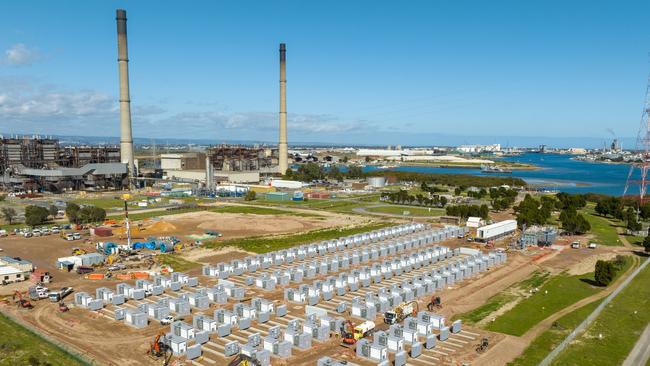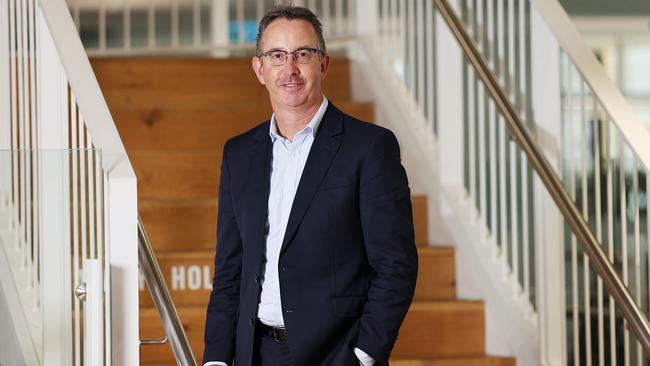AGL critical of energy price caps, posts $1.1bn loss, cuts dividends
AGL chief executive Damien Nicks says household and business energy costs will stay elevated over the next two years, despite wholesale power prices falling from last year’s highs.

Business
Don't miss out on the headlines from Business. Followed categories will be added to My News.
AGL chief executive Damien Nicks says household and business energy costs will stay elevated over the next two years, despite wholesale power prices falling from last year’s highs.
Speaking after AGL delivered its half-year result on Thursday, Mr Nicks said that the federal government’s energy price intervention had driven down forward pricing for 2023 and 2024, but they still remained higher than levels seen two years ago.
“It‘s obviously dropped off. But what we’re seeing is the 2024 curves are still higher than 2020 and 2021. So ultimately, that will sort of drive through to pricing and our earnings,” he said.
“What‘s important though, when we think about customer price is not just the wholesale curve, it’s the network costs and a whole range of other factors that go into it. But we are seeing – as has been quite publicly made known – we are still looking at increases into next year.”
AGL shares were battered on Thursday after the company booked a $1.08bn statutory net loss for the first half of the year, and halved its dividend to 8c a share after booking an underlying after-tax profit of $87m for the half, down from $194m at the same time the previous financial year.
The company also downgraded its full-year net profit guidance to between $200m and $280m, down from an earlier estimate of $200m to $320m.
And AGL joined the criticism of the federal government’s caps on gas and coal prices, saying it was concerned by the uncertainty it caused for miners and gas producers, despite noting the caps had helped reduce forward wholesale power prices.
Mr Nicks told The Australian AGL was confident of its gas and coal supplies for this coming winter, but said the company was concerned that long-term shortages may emerge if resources companies stopped investing in new gas projects if price caps remained in place.
“If people stop investing, whether it be in gas or coal, that has a longer term impact on the market. That‘s the concern we have,” he said.

Mr Nicks told analysts the company supported some of the federal government’s intervention in energy markets, aimed at keeping household and business energy costs down.
“While we do support certain measures, namely the customer bill rebates as well as the role of the Safeguard Mechanism, we are concerned that the commodity price intervention has created regulatory uncertainty for coal and gas suppliers, undermining their business and investment confidence,” he said.
AGL said on Thursday the company recorded customer growth across its electricity, gas and telecommunications businesses, but its results were impacted by an 8.4 per cent rise in the cost of fuel across the period, compared to the first half of the previous financial year, with the cost of gas up 15.8 per cent across the period.
But the final result was dominated by the $1.08bn worth of asset impairments booked by new chief executive Damien Nicks, after the company slashed the value of its generation assets, reflecting its September decision to bring forward the closure of the Loy Yang power station in Victoria and exit coal-fired generation completely by 2035.
AGL chief financial officer Gary Brown said the challenging start to the financial year, which saw a significant unplanned outage at second unit at the company’s Loy Yang A power station in Victoria, had a significant impact on the company’s half-year results.
The Loy Yang outage cost the company $73m in lost revenue, with the market volatility in July – which included sharply higher pool power costs – costing the company another $135m.
“July was a particularly challenging month for AGL, with the confluence of planned and forced outages across our coal-fired fleet resulting in a short generation position,” he said.
“Compounding this short position, AGL experienced significantly higher pool prices which were driven by heightened winter energy demand, as well as elevated fuel input costs due to the spike in global commodity prices.”
But Mr Nicks said AGL did not expect a repeat of the difficult winter period, having upped its maintenance spending ahead of the winter period in an effort to reduce the chance of further failures at its generation fleet.
“Our main priority is minimising equipment failures that may result in future unplanned outages and derates. This includes additional preventive maintenance on mills, precipitators and chemical cleans of boilers to reduce known failure modes such as tube leaks,” he said.
“We are also bolstering preventive maintenance through stronger inventory management to ensure that, where appropriate, critical spares are held on site or accessed within a reasonable time frame. Repairing Loy Yang A Unit 2’s spare rotor and stator is an example that would provide a shorter return to service time if such an incident were to reoccur.”
“Sizeable capex investments have also been made to increase the reliability and efficiency of our fleet, with upgrades to the turbine and generators of the Bayswater units, as well as further investment in Digital Control Systems, which enables us to flex each Bayswater unit by nearly 500 megawatts.”
Barrenjoey analyst Dale Koenders said on Thursday that, while the AGL results demonstrated that higher power prices would remain for longer, the company’s hedging position meant that may not immediately flow through to its bottom line.
“We should see this earnings recovery in the 2024 financial year, which underpins long term value in the name, but with heightened government intervention, the question is how much of these earnings will be used to subsidise customers?” he said.
“The market got the wrong signal from Origin’s guidance update, and had assumed something similar from AGL, but unfortunately AGL does not have the same positive exposure to high spot gas prices.”
AGL shares closed down 82c, or 10.3 per cent, to $7.12 on Thursday.
More Coverage
Originally published as AGL critical of energy price caps, posts $1.1bn loss, cuts dividends





